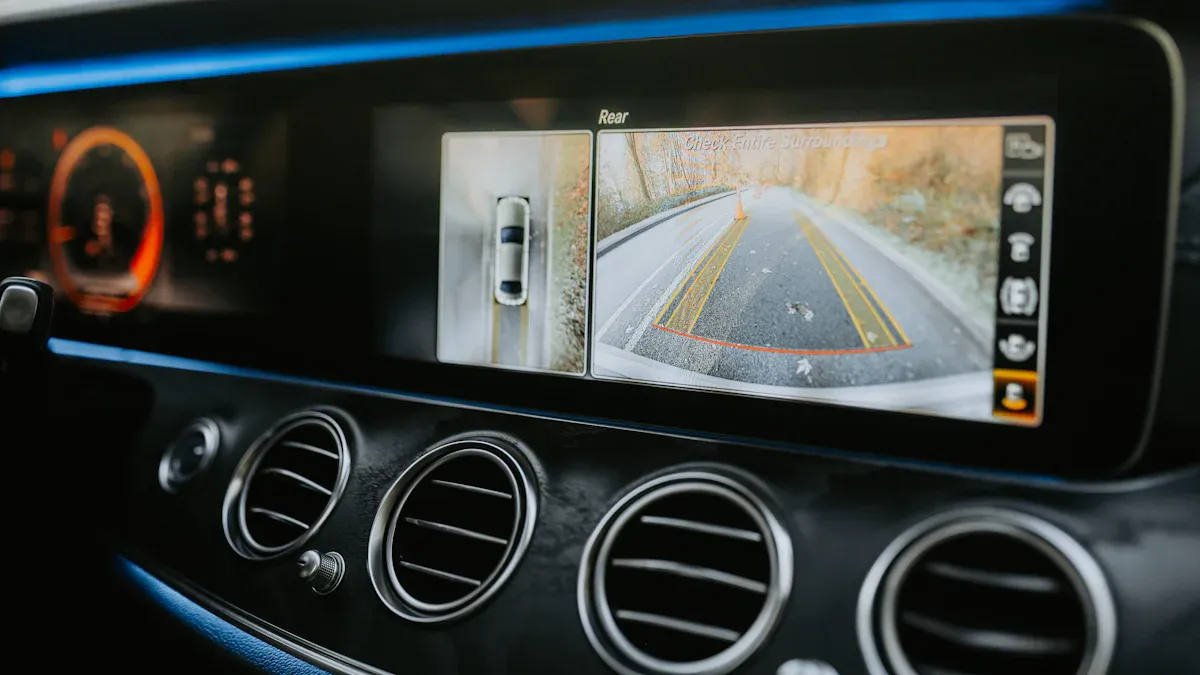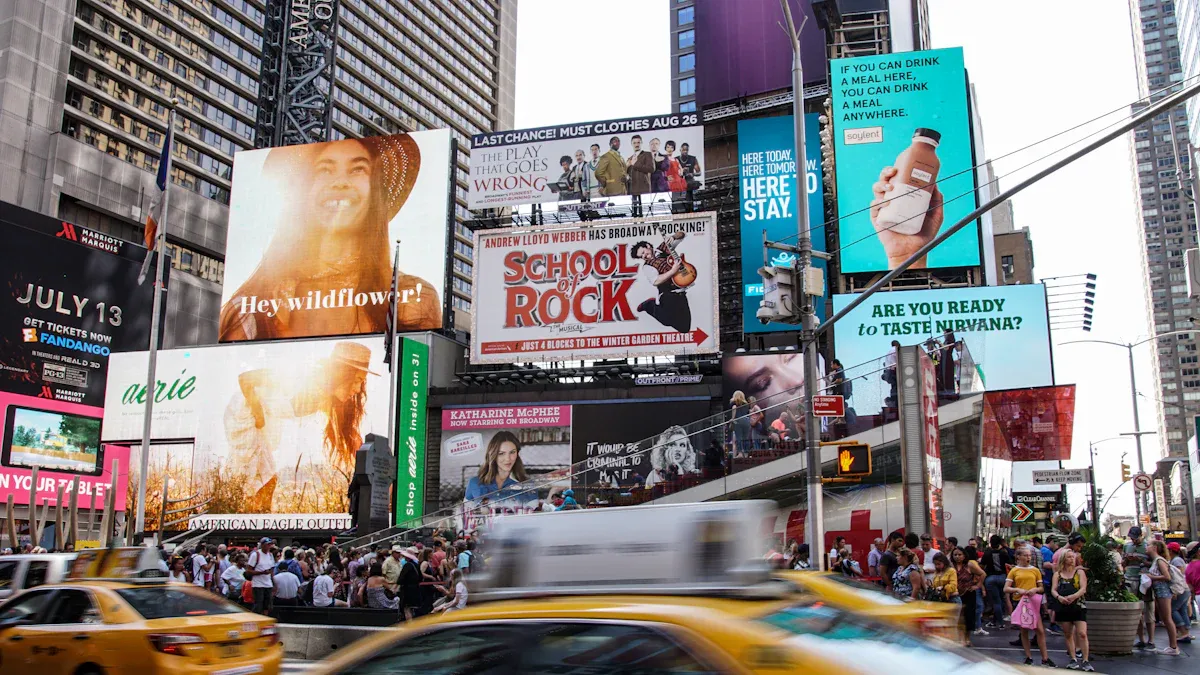
Rear-mounted advertising screens for ride-hailing vehicles show digital ads to people behind the car. You can see these screens on Uber or Lyft cars as a type of mobile advertising. Companies use these screens to reach people stuck in traffic or walking on busy streets. You notice this kind of advertising because the screens catch your eye. Rear-mounted advertising screens for ride-hailing vehicles help brands reach people in real time.
These screens make normal rides into moving billboards. They make city streets more fun and interesting for you and others.
Key Takeaways
Rear-mounted advertising screens make ride-hailing cars moving billboards. They show bright and clear ads to people outside the car.
These screens use smart technology to change ads from far away. They can pick certain places to show ads. They also collect data to help ads work better.
Drivers get extra money for showing ads on their cars. They earn more when they drive in busy places.
Advertisers can reach more people right away. This helps people remember their brands and makes ads work better.
Passengers see fun and helpful information during rides. This can make their ride better and help them trust brands more.
Rear-Mounted Advertising Screens Overview

What They Are
You can spot rear-mounted advertising screens on Uber and Lyft cars. These screens turn cars into moving billboards. They use digital signage to show ads and information to people outside. The screens have high-resolution displays, so pictures and videos look clear and bright. This helps brands reach people right away, especially in busy cities. On-vehicle digital signage is important for mobile advertising. It makes brands easier to see and ads more fun to watch.
On-vehicle digital signage uses changing content to get your attention. It keeps ads new and exciting.
Some ride-hailing cars also have digital signage inside. For example, there are touchscreens or screens on the back of seats. These show ads to passengers and sometimes let you touch the screen. Drivers can earn more money by showing these ads.
Where They’re Installed
Rear-mounted advertising screens are usually on the outside of the car. Most of the time, they are on the rear window or the back of the car. Some cars use taxi top LED displays on the roof. These face people behind the car or walking by. These screens help more people see the ads, especially in traffic.
Inside the car, you might see screens on the back of the front seats. These screens face passengers and show ads based on your trip. This way, on-vehicle digital signage works for people inside and outside the car.
Key Features
Rear-mounted advertising screens use new technology to make ads pop. The displays are high-resolution and stay bright in sunlight. The screens use LED or LCD panels for clear images and videos. On-vehicle digital signage can be controlled from far away. Companies can update ads using the cloud and track screens with GPS. This lets them change ads fast and pick where to show them.
Here is a table with some main features of these screens:
Feature | Details |
|---|---|
LED Type | Nationstar SMD1415 |
Pixel Pitch | 2.5 mm, P2.6 mm, P3.1 mm |
Resolution | 384 (W) x 128 (H) pixels |
Brightness | 5000 – 5500 nits (readable in daylight) |
Transparency | |
Size | 1010 mm x 432 mm x 98.5 mm; 756 mm x 250 mm; 804 mm x 280 mm |
Weight | 18.5 kg; 2.8 kg |
Power Consumption | Max 450 W / Avg 180 W; Avg 48 W per panel |
Control Mode | |
Refresh Rate | ≥1920 Hz |
Design | Ultra slim, aerodynamic, weatherproof (IP56), aluminum alloy cabinet |
Mounting | Roof rack, suction cups, no drilling required |
Additional Features | Auto brightness control, GPS trace, cloud platform integration, electrostatic protection |
Durability | Weather resistant, suitable for all vehicle types |
On-vehicle digital signage helps brands get noticed and drivers earn more. The screens use smart technology to show ads that fit the time and place. This makes mobile advertising work better and helps brands reach you wherever you are.
How On-Vehicle Digital Signage Works
Content Management
You use cloud software to control on-vehicle digital signage. This lets you upload and manage ads from anywhere. You do not need to touch the car’s screen. First, you make an account on the cloud platform. Then you log in and upload your videos or pictures. The software lets you pick when and where each ad shows up. You can set ads to match the time or place of the car. This means you can show things like weather or local deals right away.
Here is a table that shows how you manage content:
Step | Action |
|---|---|
1 | Make an account on the cloud platform |
2 | Set up the software with WiFi or 4G |
3 | Upload your videos or pictures |
4 | Set up the hardware (controller card, GPS antenna, 4G module) |
5 | Turn on the display |
6 | Link the display to the cloud with its serial number |
7 | Manage, schedule, and check ads and info from far away |
You can also change the brightness or fix problems without being near the car. GPS helps you send ads to people in certain places.
Connectivity and Power
On-vehicle digital signage stays connected in different ways. WiFi lets you update ads when the car is parked. If there is no WiFi, the system uses 4G or 5G. This keeps the screens updated while the car moves. GPS helps the system know where the car is. This way, you can show ads for certain areas.
The screens get power from the car’s battery or alternator. They use special tech to save energy. For example, an outdoor LED screen might use about 92 watts per square meter. This means you can run the screens for a long time without using too much battery.
Data Collection
On-vehicle digital signage does more than show ads. It collects real-time data about the area and the system. Sensors check things like temperature, humidity, and if the screen works. The system sends this data to you through the cloud. You can see if the screen is working or needs fixing. GPS also helps you track the car’s route and see which ads get seen most. This feedback helps you make better ads and reach more people.
With on-vehicle digital signage, you get a smart system. It gives real-time info, changes to fit your needs, and helps you reach more people every ride.
Benefits for Drivers, Advertisers, and Passengers
For Advertisers
You can show ads to people who cannot look away. These screens help your brand get noticed in busy places. Your message reaches people stuck in traffic or walking by. This makes more people remember your brand. On-vehicle digital signage lets you pick ads for certain places or times. You can also see how many people notice your ads and what they do.
Advertisers get these benefits:
Change ads fast and anytime.
See results with data and numbers.
Show ads to people who have to watch.
Make extra money by working with drivers.
Tip: On-vehicle digital signage helps you show ads to the right people at the best time.
For Drivers
You can make more money with rear-mounted advertising screens. When you let ads play on your car, you get paid for each ad campaign. Some systems pay you when riders use codes from the ads. This links your driving to your earnings. You help brands reach people who have to see the ads. The more you drive in busy places, the more you can earn.
Benefit | Description |
|---|---|
Extra Income | Make more money by showing ads on your car |
Direct Payments | Get paid when people use codes or click ads |
Flexible Participation | Pick when and how you show ads |
Increased Brand Recognition | Help brands get noticed by more people |
Maximizing Advertising Impact | Drive in busy areas to show more ads and earn more |
For Passengers
You see that on-vehicle digital signage makes rides more fun. The screens show cool ads and helpful info. This can make your trip feel faster and better. You notice brands that care about new ideas and good service. This helps you trust them more. The screens often make you feel good about your ride. You get to see new products and deals while you travel. This can make you like the ride-hailing service and the brands even more.
Passengers often think on-vehicle digital signage makes rides better by giving fun and info, and helps brands get noticed.
Measuring Effectiveness of Digital Wraps and Taxi Top Digital Billboards

Tracking Impressions
You can measure how many people see digital wraps and taxi top digital billboards in several ways. GPS-enabled advertising platforms help you track where your ads travel and how many people might see them. These systems show you real-time impressions and the geographic reach of your campaign. You can also use QR codes or special promo codes on your digital wraps. When someone scans a code or uses a promo code, you know they saw your ad and took action. Social media plays a big role, too. Many brands ask people to share photos of digital wraps online. This helps you see the true impact of your campaign beyond just counting views.
GPS tracking and digital tools give you a clear picture of your ad’s reach and audience.
Analytics and Reporting
You get detailed reports that show how well your ads perform. Programmatic digital out-of-home (DOOH) advertising lets you see metrics like store visits, app downloads, and website clicks. You can check which neighborhoods your ads reach and what times work best. This helps you understand the impact of your digital wraps and make better choices for future campaigns.
Here are some key findings from recent reports:
Uber and Lyft use car-top screens to reach millions of people each month.
Ads can change based on location and time, so you target the right audience.
You can track real results, such as more store visits or app downloads.
Digital wraps often lead to higher driver ratings and more tips.
The digital OOH market grows faster than traditional billboards, showing strong impact.
You can use these analytics to see what works and improve your next campaign. With the right data, you make sure your digital wraps have the biggest impact possible.
Rear-mounted advertising screens help you reach city people easily. Advertisers, drivers, and passengers all get something good.
Advertisers can show ads to the right people fast. They can also change ads quickly for better results.
Drivers make more money and get safety tips from the screens.
More people want in-taxi digital signage because of new tech. The market is growing quickly. In the future, screens will show cooler, greener, and more personal ads as ride-hailing gets bigger.
FAQ
What types of ads can you show on rear-mounted screens?
You can show videos, images, and animations. Many brands use these screens for local deals, event promotions, or new product launches. The screens support bright colors and moving graphics, so your ads look clear and eye-catching.
Do these screens distract other drivers?
You do not need to worry. The screens use safe brightness levels and avoid flashing lights. Most cities have rules to keep digital ads safe for everyone on the road.
How do you update the ads on these screens?
You can update ads remotely using cloud software. Just log in, upload your new content, and schedule when it should play. The system sends updates to the car over WiFi or 4G.
Can you track how many people see your ad?
Yes, you can. The system uses GPS and data analytics to estimate how many people see your ad. You also get reports that show impressions and engagement.
Will the screens drain your car battery?
You do not need to worry about battery drain. The screens use energy-saving technology and connect to your car’s battery or alternator. Most systems monitor power use to keep your car running smoothly.
See Also
Budget-Friendly Portable CarPlay Solutions Suitable For All Drivers
Best HDMI Dongles For CarPlay 4K Streaming In 2025
Audi Tesla-Inspired CarPlay Displays Reviewed By Features And Cost
Top CarPlay Dongles Supporting Netflix Compared And Reviewed
Understanding Wireless CarPlay Adapters And Their Driving Benefits
